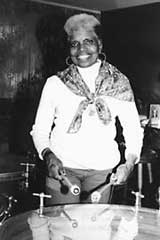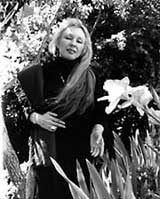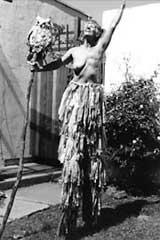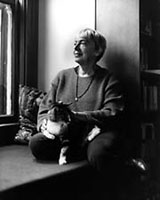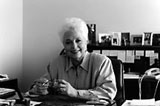|
Excerpt: On Women Turning 60:
Embracing the Age of Fulfillment
Introduction
When I first started thinking about women in their sixties, I was
surprised about how many of whom I thought Oh, she can’t be
in her sixties. How vital and dynamic these women are! Like most
individuals in Western culture, I, too, had fallen prey to the myth
(as Riane Eisler, Rose Styron, and others articulate in this book)
that for a woman in her sixties her “youth is gone,” that
she is “over the hill” and needs to be put “out to
pasture.” I was dismayed to discover that I myself held this
stereotype about women in their sixties. On Women Turning 60: Embracing
the Age of Fulfillment shatters the fallacy of “over the hill”
once and for all. And, good riddance!
On Women Turning 60: Embracing the Age of Fulfillment is a collection
of interviews with women from diverse cultural, geographic, economic,
and professional circumstances, and assorted lifestyles. This book
presents dedicated women between the ages of sixty and seventy who
share passionate concerns about their lives and pioneering visions
for the world. By developing their intrinsic inner authority, the
following women have devised their own “initiations” into
a productive later life or third age. On Women Turning 60 explores
the effects on women’s lives of aging, meaningful work, relationship,
feminism, creativity, and spirituality, in a deeply personal manner.
It offers women in their later years a variety of role models to
contemplate and hold as positive internal images. It gives the reader
a feeling of pride and strength in her maturity and provides alternative
ways of viewing herself and of moving through her remaining years.
Although I am “only” forty-eight (Einstein was right:
Everything -- including age -- is relative), I have cloistered my
own fears of aging. Undoubtedly, this apprehension has been the
fundamental motivating factor for my ten-year-long study on the
subject of women and aging. My previous books on the subject: On
Women Turning 40: Coming into Our Fullness and On Women Turning
50: Celebrating Midlife Discoveries, along with my nation-wide workshops
for women in midlife, have acted as an analgesic on my anxiety about
aging. Perhaps the singular most affecting benefit I personally
have received from my work is the opportunity to confront these
demons of dread head-on and unmask them for what they are: a fiction.
In so doing I then have the privilege of sharing my revelations
with you, the readers of this book.
Who are women in their sixties? Women over sixty-five are the fastest-growing
segment of the United States population. They are our mothers or
grandmothers, our sisters, our aunts, our neighbors, teachers, and
friends. They are ourselves, either now or later. This book offers
insights into the sixty-something woman’s consciousness: her
joys and sorrows, her aspirations and compromises, her liberties
and responsibilities, her visions and restraints. It can help us
to understand these women and eventually ourselves at their age.
These women are role models and trail-blazers who are helping to
free society from its handicap and constraints of ageism; from the
epithet of “over the hill.” The women in this book are
guides for how to “grow” older rather than to “get”
old. They offer us the wisdom of their years and it behooves us
to acknowledge them.
While writing On Women Turning 60, I came across a film that beautifully
elucidated this myth of “over the hill.” Appropriately
titled, Over the Hill, it starred Oscar-winner Olympia Dukakis as
a widow named Alma. It begins at her sixtieth birthday party in
her new basement apartment in Bar Harbor, Maine. The apartment has
recently been remodeled by Alma’s well-meaning son, Steven,
in order to accommodate her. Alma has been coerced into selling
the home in which she had lived with her husband and raised her
two children because, now as a single woman, “the family”
feels that it is too large for her to keep up on her own and that,
as “an older woman,” she would be “much better off”
living with them. Unfortunately, Alma (which means “bountiful
or nourishing” in Latin and “soul” in Spanish) is
not consulted about what she wants for herself. Rather, she is made
to feel that her “youth is gone,” that she is “over
the hill” and needs to be put “out to pasture.”
Alma looks bewildered and her submissive body language indicates
that she has resigned herself to the future of invisibility that
is allocated to all “old” women. She appears, at first,
to accept her fate. But, as Steven hands her a birthday cake that,
like a portentous fiery Medusa’s head, blazes with five dozen
candles, Alma, without a word, walks calmly and purposefully upstairs
and, opening the front door, heaves the cake out on its face into
the snow as if she were exorcising a demon. She is, of course, the
demon of compliance, of fearful acquiescence, the demon of self-doubt
and defeat. The look on Alma’s face is one of triumph mixed
with the glee of an eleven-year-old who has just disobeyed her parents
for the first time and affirms to herself incredulously, “I
did it!”
The palpable rage toward family, life circumstances, age, fate,
and herself, that led to the action of this fictional character
are genuine and recognizable to every woman who is accused of, or
sees herself as being, “over the hill.”
In the next scene we are shown a 747 jetliner flying over the Great
Barrier Reef in Australia and we learn that Alma has run away from
“home.” In Sydney, she arrives unannounced and uninvited
at the estate of her estranged daughter, Elizabeth, and son-in-law.
The couple, caught up in their own lives, are quick to convey to
Alma that she is not only unwelcome but, worse, an embarrassment
to them.
Feeling as though she has nothing to lose, Alma buys a souped-up
1959 Chevy Bel Air from her granddaughter’s boyfriend and drives
off “over the hill,” into the bush, and on her way to
Melbourne where she plans to “loupe the loupe” by making
a complete circuit around the Australian continent. “Travel
broadens the behind,” she impishly tells her stunned daughter
as she revs the throttle. This double entendre on the phrase “over
the hill” brings a second, more constructive, and hopeful meaning
into play. Rather than washed up, wasted, and of no use, we begin
to associate “over the hill” with independence, adventure,
determination, and new horizons, vistas and perspectives. As Alma,
in her duckbill cap and black mirror wrap-around eye shades, heads
into the Australian outback alone, we root for her, we’re proud
of her, and we identify with her spirited demonstration of defiance.
Ironically, Over the Hill was directed by George Miller, the man
who helped Mel Gibson sweep to world-wide recognition in the macho
films Mad Max and Road Warrior. In its way, Over the Hill is a feminist
Road Warrior. It is about a sixty-year-old budding Amazon who meets
her fears of the unknown full-face and assumes responsibility (probably
for the first time, the film suggests) for her own life. We watch
as an initially naive Alma is briefly terrorized by a band of desert
hooligans, then rescued and pleasingly seduced by an eccentric retired
dentist who refers to himself as “a middle class gypsy.”
After a series of escapades suitable for an Amazon, Alma, at last,
(in the words of Ursula Le Guin) “becomes pregnant with herself.”
After a lifetime of taking care of others, Alma, the nourisher,
learns how to nurture herself. Alma/soul enters the world of soulmaking.
As a result of her experiences, she is rewarded with the self-confidence
to live her own life and the courage to choose what that life will
be. She refuses to accept anyone else’s prescription for her
life. Alma discovers that, far from being “over the hill”
in the negative sense, her life is filled with potential for growth,
adventure, love, friendship, sex, and, above all, independence.
She has recognized and embraced the age of fulfillment.
Because several women I interviewed for this book spoke to me about
their fears of being considered by others as “over the hill”
-- and their ultimate refusal to view themselves as such -- this
film had a special resonance for me. The women I met, like the fictional
character Alma, have struggled with feelings of self-doubt and insecurity
in regard to their age. As a sixtieth birthday gift to herself,
my friend, Susanne Short, embraced her fulfillment by embracing
the world: She circumnavigated the globe in a nine-week journey.
“I started thinking of all the things and places I wanted to
do and visit and experience before I get too old,” she told
me. Susanne visited Buddhist monasteries and temples, Islamic mosques,
and Christian shrines in Russia and the Gobi Desert, Mongolia, Bali,
and China. “It was like fulfilling a dream that I thought I
might not ever get to do,” she said, smiling. Full with memories.
Not yet old, but no longer young, the sixties can be an almost
awkward decade, for, as Carolyn Heilbrun perceptively told me, “It
can be a time of feeling very alive without any particular external
evidence of it.” According to Susanne Short, “The sixties
are such an in-between time of life; it takes some adjusting to
being in this interim. I don’t feel old -- I think of old as
being seventy-five or eighty -- and young is certainly younger than
I am. One starts to think about life in terms of time left and what
to do with it.”
Unlike menopause in the fifties and cronehood in the seventies,
there are no traditional designations for sixty, and, with the official
age of retirement inching closer to seventy, there are few limits.
In her latest book, Ms. Heilbrun exemplifies this decade in her
title: The Last Gift of Time. I think she is accurate. The women
I interviewed primarily looked forward to their sixties and, indeed,
felt them to be a gift. Because it is a decade without definition,
no one -- young or old -- seems to have any expectations of what
people in their sixties are like or should be doing. As Sue Hubbell
wrote in her New York Times Magazine article, “A Gift Decade,”
“Our sixties are like a decade-long February 29, a ten-year
leap second. I think we are getting away with something: an extra
time before old age and after life’s middle.”
During the course of researching this book, I came to understand
that women, in their sixties, such as Susanne, are older, yes, but
not -- thank you very much -- old. Phasing out of midlife and often
enjoying what Margaret Mead referred to as a post-menopausal zest,
I found women in their sixties to be entering what the French call,
the Third Age and what I call “the third third” of life.
In fact, aided by a vigorous life of the mind, the creative powers
of many women I met are only now beginning to peak. As sixty-four-year-old
British novelist Fay Weldon optimistically told me in regard to
her creativity: “There’s always more where that came from!”
At sixty-three, former Texas governor, Ann Richards believes that
she has “at least twenty good years left.” While, at sixty-five,
author and futurist Riane Eisler counts on working another thirty
years. “Over the hill”? Hardly.
After sixty, there is often an increased level of self-confidence,
personal authority, a deepening trust of the inner process, and
an ability to be present in, pay attention to, and appreciate the
“now.” An older woman can have as much or more vitality,
passion, and focus than a younger woman half her age. I have seen
them. I know them. And, heaven forbid, there is still sex -- in
variance to what Francine du Plessix Gray cagily regards as, “the
quaint taboos that still shroud the association of carnality and
old age” -- even if it is “only” “sex with one”
as quilter Virginia Harris, who is single, calls it.
Is it true that memory diminishes with age as the current theory
would have us believe and therefore fear? Not according to tympanist
Elayne Jones, sixty-eight, who remembers literally hundreds of scores
to operas and symphonies as well as (without hesitation, I might
add) the names of people and places she knew and visited either
yesterday or more than fifty years ago. A number of women did make
reference to their “poor memories,” but I discovered that
a recent study in Italy shows that the reason for the apparent decline
of memory in the elderly may be loss of self-confidence (italics
mine). Latest research indicates that while the human brain may
lose some of its speed and capacity with age, this decrease is offset
by other aspects of intelligence that are honed by practice, and
function best in later life. Unsurprisingly, it was noted that our
mental attitude influences the brain. An up-beat, cheerful outlook
improves brain function at any age.
What are women in their sixties doing with their lives? The women
I met are: teaching other women to “fly” on low-flying
trapezes and to “walk tall” on stilts; rewriting school
curriculums; working with rape victims in Bosnia; educating the
world about chimpanzees and other wildlife; mentoring the young;
raising funds for elders; performing in symphony orchestras; directing
plays; writing poetry and novels; acting in films; singing in concerts;
lobbying for rights in Washington, D. C.; traveling the globe on
behalf of world peace; making quilts; analyzing handwriting; and,
would you believe? learning to surf. Nothing seems impossible to
these women.
Few women I met can imagine themselves retiring: “I expect
to die, but I don’t plan to retire,” Margaret Mead once
stated. “I’ll drop dead first!” was graphologist,
sixty-seven year old, June Canoles’ adamant assertion. Both
Ann Richards and Elayne Jones look forward in later life to buying
sea-side properties on, respectively, the Gulf Coast, and in Barbados.
Rose Styron, sixty-three, who is addicted to travel, expects to
be hiking off into the sunset as long as her body can carry her.
Primatologist, Jane Goodall, sixty-three, whose mother and father
are ninety-four and ninety-six, dryly says, “Nobody dies in
my family.” She, therefore, expects her hearty ancestry to
transport her through at least another three decades. However, poet,
Nellie Wong, sixty-three, who began working at sixteen, looks forward
to retiring in two years when she can devote herself more to her
writing and the political causes she fosters. She says she will
also enjoy “going to the movies at a senior discount.”
Because the world of the Arts -- literature, cinema, theatre, dance,
music, opera -- are alive for us with sociological relevance, we
look to them as a mirror of the Zeitgeist and as paradigms for ourselves
in our own lives. The Arts assist us in viewing ourselves as we
are or as we wish to become. They provide a context in which we
can observe what society is thinking about us and itself. In contemporary
art forms we are seeing more constructive and enthusiastic role
models of women in their sixties. In 1995, on Broadway, I saw a
superb production starring not one but two sixty-something actresses,
Vanessa Redgrave and Eileen Atkins (who also adapted the play),
in Vita and Virginia, the story of the intense love affair between
the writer Virginia Woolf and the novelist Vita Sackville-West.
In the film Unhook the Stars, Gena Rowlands, sixty-six, plays a
lonely widow in her sixties who begins to partake in life and laughter
once more through her friendship with a small neighborhood boy.
In this movie she also dates a much younger man, a truck driver,
played by Gerard Depardieu. Talk about fulfillment! In the 1994
film Summer House starring a radiant and vivacious Jeanne Moreau,
Mademoiselle Moreau, then in her mid-sixties, portrayed a wise,
but obviously still sexy older woman who, with a flare of true panache,
helps save her niece from a fate worse than death: a loveless marriage.
And from the author of the widely read early feminist novel The
Women’s Room, comes the most recent novel from Marilyn French
(a woman in her sixties) about an aging heroine, an adamantly erotic
romance novelist, who finds herself, once again, ambushed by love.
In My Summer with George, Ms. French challenges convention and pungently
raises the possibility of a full romantic life for a woman in her
sixties. Encore!
Unforeseen, but very gratifying, I found that vanity plays less
of a role in the lives of women in their sixties than it does for
women in their forties and fifties. Women in their sixties grasp
that, as Betty Friedan wrote, “It takes so much effort to hold
onto the illusion of youth, to keep the fear of age at bay.”
It was a real relief to discover that most of these women no longer
worry about how they look. They care about looking their best, but
not to the exclusion of more pressing matters like writing novels
or directing plays or working for world peace or gardening or quilting
or stilt-walking, or spending time with grandchildren or friends,
or just going out in nature for a walk. I wondered if this is because
women now in their sixties are the last generation to be spared
the compulsively addictive concern with how their bodies and faces
age. (The next generation down and subsequent generations of baby
boomers have come to be obsessed with their looks.) Or does this
ease with the basic process of aging come naturally to us at a certain
point in our daily routine when we more readily redirect our attentions
into other areas? Of course some women become even more militant
about their looks as they try to beat back the years. In this attempt
they may have facelifts or dye their hair or painfully adhere to
an insistent and merciless regime of diets and exercise.
Louise Erdrich calls these women, “Valiant Looks Warriors,
hard-working, airbrushed grandmas, who refuse to go gently or at
all.” I know what she means. A few weeks ago I saw a well-known
actress, who is only fifty (funny how young fifty now seems, isn’t
it?), on the Charlie Rose show. She looked as though it hurt to
smile! True, she didn’t have any wrinkles, but what price beauty?
I’ll take the late Italian actress -- the haggard, earthy,
love-besotted -- Anna Magnani who said to her director Federico
Fellini, “Don’t retouch my wrinkles, it took me so long
to get them.” Germane to this is George Bernard Shaw’s
statement comparing the French actress Sarah Bernhardt, who apparently
wore gobs of make-up, with another Italian actress Eleonora Duse,
who wore relatively little: “I prefer the Italian because her
wrinkles are the credentials of humanity.”
Still, cosmetic surgery or not (as each woman must decide for herself),
there is the need for what one woman called “higher maintenance,”
as she good-humoredly grumbled about having to take twenty minutes
in front of a mirror each morning in her sixties as opposed to the
five it had always taken her before when she was younger. Consistent
with the wish to make less of a fuss with their physical presentation,
there seems to be an undercurrent of desire to simplify: “Just
keep it simple,” was a stipulation I heard from a number of
women. And Jungian analyst, Marion Woodman at sixty-eight, is following
that advice by cleaning out years worth of her files of notes, boxes
of pictures, and closets of old clothes, “I’m getting
life down to the essence,” she said with a wise smile.
That “essence” was expressed by others in the term soulmaking,
which was epitomized by the aforementioned film Over the Hill. This
concept is built into the Hindu view of human life in which, after
a certain age, according to writer Ursula Le Guin, age sixty-eight,
“When a woman gets older she drops most of her plates and concentrates
on learning to be alone. She focuses on her spiritual powers.”
Dancer Luly Santangelo, sixty, calls this the “distillation
process” when a woman becomes “more economic with her
energy.” By the time they reach their sixties, women know who
they are, what is important to them, and how they wish to spend
(or not spend) their time. There is what could be called a wise
distribution of energy. In a recent telephone conversation with
the writer Barbara Grizzuti Harrison who is sixty, she humorously
signed off from me by saying, “Well, I’ve got to get back
to doing nothing.” Women in their sixties are gutsy, dauntless,
and emboldened to be exactly who they are and to say exactly what
they think and feel.
Unquestionably, I believe this growing concern with a spiritual
life during the seventh decade is directly related to an increased
cognizance of one’s mortality, a recognition of finitude. As
Virginia Harris, sixty, explained, “We know that our destination
is death.” The eventuality of death is very real to these women.
But, rather than holding them hostage in a paralyzed state of fear,
it seems to add an intensity to their lives. They become more committed,
in the Buddhist sense, to living fully in the present moment and
less concerned with either their past or future.
This heightened awareness seems to have less to do with an actual
fear of death, than with the dread of an incapacitating illness,
either physical, mental, or emotional. Matilda Cuomo spoke to me
at length about her involvement with raising funds for breast cancer
research after losing twenty-one friends to this disease that has
reached epidemic proportions. Three of the women in this book have
survived cancer. And Nabeela George, a woman who had lived with
the crippling effects of polio since she was eleven months old,
was diagnosed with breast cancer two weeks prior to my interviewing
her for this book. Three months later she was dead. I have chosen
to include her as I feel that her inspiring story merits telling,
but also because the sobering fact is: Women can and do die in their
sixties. In a society that unrelentingly seeks to avoid the reality
of death, we need inspiring forerunners who move through this passage
with courage, heart, and tranquility, and who teach us how to die.
The seemingly eternally youthful Audrey Hepburn died at the age
of sixty-four, Jackie Onassis, who appeared to be at her peak of
happiness in terms of a satisfying career, a meaningful romantic
relationship, and a joyous involvement with her grandchildren, was
just sixty-three. Who among us did not take for granted that these
icons of beauty and success would endure forever? During the course
of writing this book, the beloved former Democratic Congresswoman
from Texas, Barbara Jordan, succumbed to complications from multiple
sclerosis at the age of sixty. Illness and mortality seem synonymous
with aging. But it can be helpful to view the impermanence of life
as a gift or a wake-up call to the present moment and the appreciation
and fulfillment of the time left.
Financial security is another major concern of aging women -- and
should be. Women over sixty-five are the fastest-growing segment
of the United States population, and one in five lives in poverty.
“If you are a woman,” writes one economist, “you
have a sixty percent shot at being poor in old age.” Even Ann
Richards revealed to me that the rather unlikely possibility of
her becoming a Bag Lady is her “greatest fear.” Two of
the women in this book, for lack of funds, do not carry health insurance.
They each told me that because they “cannot afford to get sick,”
they take special care planning and following their diet and exercise
programs.
When I think about women in their sixties -- actual, living entities
-- it is hard to believe that many of them, such as the “sex
kitten” of the 1950s, Brigitte Bardot, are in their sixties.
To give you a vivid picture of the spirit of aliveness that can
exist at sixty, the following is only a partial list of the names
of the most recognizable women in their early-, mid-, and late-sixties:
Elizabeth Taylor, Joanne Woodward, Shirley MacLaine, Anne Bancroft,
Gena Rowlands, Ellen Burstyn, Barbara Walters, Ruby Dee, Eartha
Kitt, Rita Moreno, Julie Andrews, Carol Burnett, Debbie Reynolds,
Mary Tyler Moore, Claire Bloom, Gloria Steinem, Helen Frankenthaler,
Kate Millet, Cicely Tyson, Trish Brown, Olympia Dukakis, Toni Morrison,
Jeanne Moreau, Adrienne Rich, Sophia Loren, Edna O’Brien, Yoko
Ono, Maya Angelou, Della Reese, Vanessa Redgrave, Joan Didion, Eleanor
Coppola, and Jill Ker Conway. If these women’s lives, which
are representative of lives filled with creative expression, are
possibilities of what we have to look forward to in our sixties,
what are we afraid of?!
Far from being “over the hill,” the women mentioned above
and those on the following pages offer us a hopeful, yet realistic
look at the possibilities that await us as we “grow” rather
than “get” older. We should celebrate our aging process,
be thankful for our life, and embrace the decade of the sixties
as the age of fulfillment that it represents. Instead of being (as
performance artist Rachel Rosenthal, sixty-nine, expressed it) “bamboozled
by the completely denigrating views of chronological time and what
it means,” which are commonly held by our society, we must
respect and enjoy ourselves and each other as older women for the
receptacles of knowledge, experience, and wisdom that we are and
for the sheer amount of time we have spent on the planet.
The women in On Women Turning 60: Embracing the Age of Fulfillment
are altering the image of age. They are champions, heroines, if
you will, at the forefront of change: Changing a society obsessed
with the fantasies of maintaining youth to one driven by the realities
and potentialities of age. In the words of Dorothy L. Sayers, they
“believe in age.” And they truly embrace the age of fulfillment.
Sixty years bring with them the privilege of discernment and vision:
A capacity to behold, in the blink of an eye, the sweeping panorama
of a life fully lived. This perspective lends itself to the metaphor
of the tapestry. “I see now,” said Marion Woodman, “how
all the threads have miraculously come together. All are woven into
the single tapestry that is my life and work.” Every woman
I interviewed spoke, in her own eloquent way, about the meshing
of her life experiences. How she now better than ever before understands,
more easily accepts, the integration of her life into a whole. How
she has come full circle and “over the hill” into the
age of fulfillment.
copyright ©1997 by Cathleen Rountree
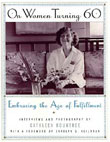
On Women Turning 60:
Embracing the Age of Fulfillment
Order either through your local bookseller or 
click this link to order from Amazon.com.
Cathleen will be happy to sign self-adhesive personalized signature labels for as many books as you purchase or already own. Email Cathleen your requests at Cathleen@CathleenRountree.com (along with your address) and she'll send the signed bookplate, which may be applied to the title page.
|


